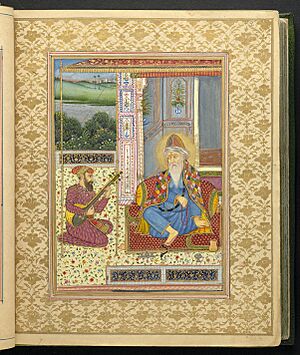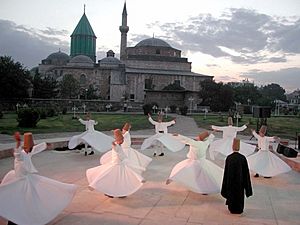Mysticism facts for kids



Mysticism is a belief that people can have a direct experience with God or with what they consider to be true reality. This experience is different from learning about God or reality through books, religious ceremonies, or other people. People who follow this path are called mystics.
Mystics can be found in most religions around the world. However, not everyone who practices a religion is a mystic. Mystics might experience special visions, powerful dreams, or feel like they hear God's voice directly. They often seek a deep, personal connection to the divine or to a higher truth.
Contents
What is Mysticism?
Mysticism is about a very personal journey. It's a way of understanding the world and the divine that goes beyond normal senses or logic. Mystics believe they can connect with something greater than themselves. This connection often leads to feelings of peace, oneness, or deep understanding.
How Mystics Experience Reality
Mystics often use special practices to reach their unique experiences. These might include:
- Deep meditation
- Quiet prayer
- Fasting
- Spending time alone in nature
Through these practices, they try to quiet their minds. This helps them become more open to spiritual insights. Many mystics describe their experiences as being filled with light or a sense of pure love.
Mystics in Different Religions
Mysticism is not limited to one religion. It appears in many faiths, showing how different cultures seek spiritual connection.
Christian Mystics
In Christianity, mystics often focus on a deep love for God and Jesus. They seek a direct union with the divine.
- St. Augustine of Hippo (354-430) wrote about his spiritual journey.
- John of the Cross (1542-1591) was a Spanish poet and mystic. He wrote about the soul's journey to God.
- William Blake (1757-1827) was an English poet and artist. He had many visions that influenced his work.
Hindu Mystics
Hinduism has a long history of mysticism. Many Hindu mystics seek to realize their true self (Atman) is one with the ultimate reality (Brahman).
- Adi Shankara (788-820 CE) was a great philosopher. He taught about the oneness of the soul and God.
- Sri Ramakrishna (1836-1886) was a famous spiritual teacher. He experienced God in many different forms.
Islamic Mystics
Islamic mysticism is known as Tassawuf or Sufism. Sufis seek to purify their hearts and get closer to God through love and devotion.
- Rumi (1207-1273) was a Persian poet and scholar. His poems are still very popular today. They speak of divine love and longing.
- Many other Muslim Sufi mystics are listed on the Sufism page.
Jewish Mystics
In Judaism, mysticism is often found in the study of Kabbalah. This is a deep tradition of Jewish spiritual knowledge.
- Abraham Abulafia (1240-1291) was a medieval Jewish mystic. He founded a type of Kabbalah focused on prophecy.
- Menachem Mendel Schneerson (1902-1994) was a modern Jewish leader. He taught about connecting with God in everyday life.
Buddhist Mystics
Buddhism also has mystical elements, especially in traditions like Zen. Buddhists seek enlightenment or Nirvana. This is a state of deep peace and freedom from suffering.
- Siddhartha Gautama (563 BC-483 BC) was the founder of Buddhism. His teachings are about finding inner peace and wisdom.
- Bodhidharma (440-528) is credited with bringing Zen Buddhism to China. He emphasized meditation and direct experience.
Images for kids
-
Liber Divinorum Operum, or the Universal Man of St. Hildegard of Bingen, 1185 (13th-century copy)
-
Guru Nanak and Bhai Mardana
See also
 In Spanish: Misticismo para niños
In Spanish: Misticismo para niños






